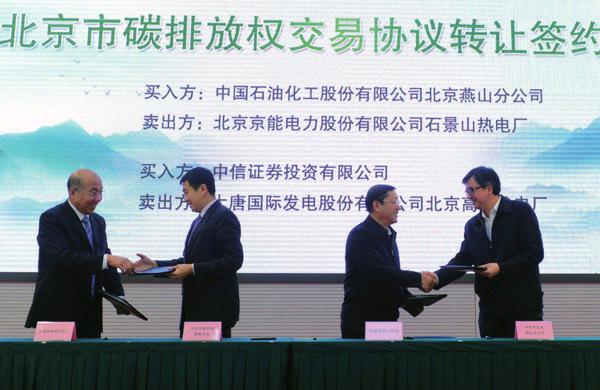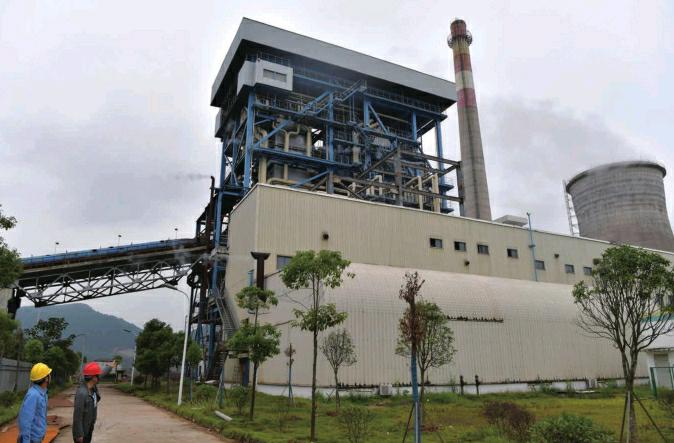Carbon Blueprint
2018-01-22ByWangJun
By+Wang+Jun
The scheme for Chinas carbon emission trading market has been approved by the State Council, and released by the National Development and Reform Commission (NDRC), according to Zhang Yong, Vice Chairman of the NDRC, at a press briefi ng held on December 19, 2017.“This marks the completion of designs for Chinas carbon emission trading system and its official launch. Once transactions start, the market will become the largest of its kind in the world,” he said.
According to Zhang, the nationwide carbon market will adopt a three-step strategy which will fi rst involve the power generation industry. “We devised the plan for the eight industries with the highest energy consumption, and found that the power generation industry has the most mature conditions because it has the most complete data and its carbon emissions are the largest; the 1,700-plus power generators emit 3 billion tons of carbon. We believe this industry is the logical starting point and will help us further improve the carbon market,” said Zhang at the briefi ng.
The system aims to establish three major structures as part of the carbon market, including a carbon emission monitoring, reporting and examination system, a quota management system for key emission units, and a related system for market transactions. There will also be four supporting mechanisms in the form of carbon emission data reporting, rights registration, rights trading and settlement.
In 2011, China started a pilot program for carbon emission transactions in Beijing, Shanghai, Tianjin, Chongqing and Shenzhen, as well as in the provinces of Hubei and Guangdong, with all transactions having been processed online since 2014.
“As of November 2017, the aggregate transaction volume had surpassed 200 million tons of carbon dioxide, worth more than 4.6 billion yuan ($704.44 million). During the course of the pilot program, both emission volume and intensity declined, helping to curb the production of greenhouse gases. Moreover, the experience amassed during the pilot program has been important for the design and construction of the nationwide carbon market,” said Li Gao, Director of the Climate Change Department at the NDRC.
Starting point
According to previous incarnations of the plan, the fi rst stage of a nationwide carbon market would cover the eight industries with the highest carbon emissions, namely petrochemical, chemical, building materials, iron and steel, non-ferrous metals, paper, power and aviation. However, the final version will first involve the power industry before incorporating the whole country.endprint
Li echoed Zhangs words, explaining that the power generation industry has the necessary measuring instrument and effective management systems, making it easy to check and allocate quotas.
Hubei Province and Shanghai are leading the way in building a national carbon emission rights registration system and a trading system respectively, with Beijing, Tianjin, Chongqing, Guangdong, Jiangsu, Fujian and Shenzhen also making contributions to the two systems.
According to the new plan, during the initial stage of the nationwide carbon market, the operation of the pilot scheme will continue. Qualified power generators will then be incorporated into the national market.
“With such a mechanism in place, those power generators with good management and low emissions per unit of production will gain more quotas as they produce more, improving their competitiveness. As the reform intensifies, these enterprises will find more space for development within the industry, while those with poor management and substandard technology and equipment will become less competitive,” said Jiang Zhaoli, Deputy Director of the NDRCs Climate Change Department.
“Overall, the burden on the power industry will be balanced, and the average costs of the industry will not rise. Moreover, in the long term, the carbon market will promote the sustainable and clean development of the power industry as the costs per unit of power generation reduce.”
According to Li, based on the outcomes of the program in the power industry, the mechanism will be extended to other industries of high energy consumption and emissions. “We are carrying out the necessary research and cooperating with related departments in order to expand the coverage of the market across every industry with the right conditions, and in the future, more enterprises will be incorporated into the carbon market,” said Li.
Liu Shuang, the program director for low carbon economic growth at Energy Foundation China, believes that the integration of the carbon emission rights trading system with other climate and energy policies will be crucial for the next step. For instance, the relationship between the carbon market with the ongoing marketoriented reform of the power industry will be key to the success of the carbon emission rights trading system. If the current power pricing mechanism is not changed, an effective carbon pricing transmission system will be difficult to establish, running counter to the original intention of reducing emissions through market-oriented means.endprint
Carbon finance
Green fi nance is currently encouraged by the government. According to a guideline jointly issued by seven ministries and commissions in 2016, fi nancial institutions in the regions covered by the carbon trading pilot scheme are encouraged to develop carbon-related financial products, such as carbon futures and carbon options. Some pilot provinces and municipalities also allow individuals to participate in carbon transactions.
Li said the government supports any appropriate financial innovation based on the steady operation of the carbon market, but carbon finance must comply with policies that seek to control the emissions of greenhouse gases because the carbon market is essentially aligned to this goal. Once the carbon market has attained stability in operation, carbon prices will be primarily decided by the market and will fl uctuate with supply and demand as well as changes in emission reduction costs.
An analysis report by Guotai Junan Securities Co. Ltd. holds that the carbon market will gradually develop into a futures market. In the initial stage, the nationwide carbon market will mainly deal in spot transactions, whose volumes reach 1.2-8 billion yuan ($183.77 million-1.23 billion) every year, and during the period from the launch of the nationwide carbon market in 2017 to the end of 2019, carbon prices may stand as low as 30-100 yuan ($4.59-15.31) per ton. It is estimated that as the carbon market transits from spot transactions to futures, the scale of the carbon futures market may reach 60-400 billion yuan ($9.19-61.26 billion) each year. Although the unit price of carbon assets dropped slightly in the fi rst half of 2017, the perfect prices of carbon transactions are expected to increase remarkably in the future.endprint
